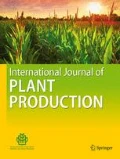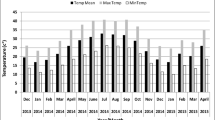Abstract
Despite being native to semi-arid environments, safflower (Carthamus tinctorius L.) growth, seed yield, and physiological responses under contrasting temperature and moisture conditions typically occurring in semi-arid regions are not fully understood. Thus, three field experiments and a greenhouse study were conducted to study the growth, yield, and physiological attributes of six safflower genotypes under different environmental conditions. Spring-sown and summer-sown plants were subjected to contrasting environmental conditions in two 4-replicate randomized complete block design (RCBD) field experiments. In the third field experiment (a 3-replicate split plot RCBD) and the greenhouse study (a 3-replicate RCBD), the safflower genotypes were subjected to different irrigation regimes of no stress to severe drought. Spring-sown safflower outperformed the summer-sown crop in terms of seed filling rate (SFR) by 93%, seeds head−1 by 62%, 1000-seeds weight by 30%, seed yield by 53%, oil concentration by 16% and protein concentrations by 22%. Plant dry mass (PDM) for the summer-sown safflower was 25% greater than the spring-sown one. In contrast to a 21% increase in seed protein concentration, severe drought led to notable decreases in leaf chlorophyll a (chl-a), chl-b and total chlorophyll (chl-tot) concentrations, leaf area, relative water content (RWC), catalase (CAT) and ascorbate peroxidase (APX) activities, membrane stability index (MSI), oil concentration, yield components and consequently seed yield (36%) and PDM (34%). Genotype Kouseh tended to maintain its seed yield and quality across the environmental conditions, potentiating this under-utilized crop as an alternative to be endorsed in crop rotations of semi-arid climates.
Similar content being viewed by others
Abbreviations
- SFR:
-
Seed filling rate
- LAI:
-
Leaf area index
- PDM:
-
Plant dry mass
- chl-a :
-
Chlorophyll a
- chl-b :
-
Chlorophyll b
- chl-tot:
-
Total chlorophyll
- RWC:
-
Relative water content
- CAT:
-
Catalase
- APX:
-
Ascorbate peroxidase
- MSI:
-
Membrane stability index
- ROS:
-
Reactive oxygen species
- SOD:
-
Superoxide dismutase
- GDD:
-
Growing degree days
- LSD:
-
Least significant difference
- EDTA:
-
Ethylene diamine tetraacetic acid
References
Aebi, H. E. (1983). Catalase. In H. U. Burgmeyer (Ed.), Methods of enzymatic analysis (pp. 273–286). Verlag Chemie.
Alizadeh Yeloojeh, K., Saeidi, G., & Ehsanzadeh, P. (2020). Effectiveness of physiological traits in adopting safflower (Carthamus tinctorius L.) genotypes to water deficit condition. Int J Plant Prod, 14, 155–164.
Almeselmani, M., Deshmukh, P. S., Sairam, R. K., Kushwaha, S. R., & Singh, T. P. (2006). Protective role of antioxidant enzymes under high temperature stress. Plant Science, 171, 382–388.
Arnon, D. I. (1949). Copper enzymes in isolated chloroplasts. 1. Polyphenoloxidase in Beta Vulgaris. Plant Physiology, 24, 1–15.
Askari, E., & Ehsanzadeh, P. (2015). Osmoregulation-mediated differential responses of field-grown fennel genotypes to drought. Industrial Crops and Products, 76, 494–508.
Cakmak, I. (2000). Possible roles of zinc in protecting plant cells from damage by reactive oxygen species. New Phytologist, 146, 185–205.
Commuri, P. D., & Jones, R. J. (2001). High temperatures during endosperm cell division in maize. Crop Science, 41, 1122–1130.
Djanaguiraman, M., Narayanan, S., Erdayani, E., & Prasad, P. V. V. (2020). Effects of high temperature stress during anthesis and grain filling periods on photosynthesis, lipids and grain yield in wheat. BMC Plant Biology, 20, 268. https://doi.org/10.1186/s12870-020-02479-0
Dordas, C. A., & Sioulas, C. (2008). Safflower yield, chlorophyll content, photosynthesis, and water use efficiency response to nitrogen fertilization under rainfed conditions. Industrial Crops and Products, 27, 75–85.
Gibson, L. R., & Paulsen, G. M. (1999). Yield components of wheat grown under high temperature stress during reproductive growth. Crop Science, 39, 1841–1846.
Graybosch, R. A., Peterson, C. J., Baenziger, P. S., & Shelton, D. R. (1995). Environmental modification of hard red winter wheat flour protein composition. Journal of Cereal Science, 22, 45–51.
Hamrouni, I., Bensalah, H., & Morzouk, B. (2001). Effect of water deficit on lipids of safflower aerial parts. Phytochem, 58, 277–280.
Haris, H. C., William, J. R. M. C., & Mason, W. K. (1978). Influence of temperature on oil content and compassion of sunflower. Australian Journal of Agricultural Research, 24, 1203–1212.
Hasanuzzaman, M., Bhuyan, M. H. M. B., Zulfiqar, F., Raza, A., Mohsin, S. M., Al Mahmud, J., Fujita, M., & Fotopoulos, V. (2020). Reactive oxygen species and antioxidant defense in plants under abiotic stress: Revisiting the crucial role of a universal defense regulator. Antioxidants, 9, 681. https://doi.org/10.3390/antiox9080681
Istanbulluoglu, A., Gocmen, E., Gezer, E., Pasa, C., & Konukcu, F. (2009). Effects of water stress at different development stages on yield and water productivity of winter and summer safflower (Carthamus tinctorius L.). Agricultural Water Management, 96, 1429–1434.
Kar, G., Kumar, A., & Martha, M. (2007). Water use efficiency and crop coefficients of dry season oilseed crops. Agricultural Water Management, 87, 73–82.
Kaya, M. D., Üpek, A., & Ozturk, A. (2003). Effects of different soil salinity levels on germination and seedling growth of safflower (Carthamus tinctorius L.). Turkish Journal of Agriculture and Forestry, 27, 221–227.
Kobata, T., & Uemuki, N. (2004). High temperature during the grain filling period does not reduce the potential dry matter increase of rice. Agronomy Journal, 96, 406–404.
Koutroubas, S. D., & Papakosta, D. K. (2010). Seed filling patterns of safflower: Genotypic and seasonal variations and association with other agronomic traits. Industrial Crops and Products, 31, 71–76.
Koutroubas, S. D., Papakosta, D. K., & Doitsinis, A. (2009). Phenotypic variation in physiological determinants of yield in spring sown safflower under Mediterranean conditions. Field Crops Research, 112, 199–204.
Mirshekari, M., Majnounhosseini, N., Amiri, R., Moslehi, A., & Zandvakili, O. R. (2013). Effects of sowing date and irrigation treatment on safflower seed quality. Journal of Agriculture, Science and Technology, 15, 505–515.
Mundel, H. H., Morrisson, R. J., Blackshaw, R. E., Entz, T., Roth, B. R., Goudiel, R., & Kiehn, F. (1994). Seeding date effects on yield, quality and maturity of safflower. Canadian Journal of Plant Science, 74, 261–266.
Nakano, Y., & Asada, K. (1981). Hydrogen peroxide is scavenged by ascorbate-specific peroxidase in spinach chloroplast. Plant and Cell Physiology, 22, 867–880.
Namjooyan, S., Khavarinijad, R., Bernard, F., Namdjoyan, S., & Piri, H. (2012). The effect of cadmium on growth and antioxidant responses in the safflower (Carthamus tinctorius L.) callus. Turkish Journal of Agriculture and Forestry, 36, 145–152.
Navari-Izzo, F., Quartacci, M. F., Melfi, D., & Izzo, R. (1993). Lipid composition of plasma membranes isolated from sunflower seedlings grown under water stress. Physiologia Plantarum, 87, 508–513.
Ozturk, E., Ozer, H., & Polat, T. (2008). Growth and yield of safflower genotypes grown under irrigated and non-irrigated conditions in a highland environment. Plant, Soil and Environment, 54, 453–460.
Peterson, C. J., Graybosch, R. A., Baenziger, P. S., & Grombacher, A. W. (1992). Genotype and environment effects on quality characteristics of hard red winter wheat. Crop Science, 32, 98–103.
Poorter, L., & Rozendaal, D. M. A. (2008). Leaf size and leaf display of thirty-eight tropical tree species. Oecologia, 158, 35–46.
Shahrokhnia, M. H., & Sepaskhah, A. R. (2016). Effects of irrigation strategies, planting methods and nitrogen fertilization on yield, water and nitrogen efficiencies of safflower. Agricultural Water Management, 172, 18–30.
Shahrokhnia, M. H., & Sepaskhah, A. R. (2017). Physiologic and agronomic traits in safflower under various irrigation strategies, planting methods and nitrogen fertilization. Industrial Crops and Products, 95, 126–139.
Singh, S., Angadi, S. V., Grover, K., Begna, S., & Auld, D. (2016a). Drought response and yield formation of spring safflower under different water regimes in the semiarid Southern High Plains. Agricultural Water Management, 163, 354–362.
Singh, S., Angadi, S. V., Grover, K. K., Hilaire, R. S., & Begna, S. (2016b). Effect of growth stage based irrigation on soil water extraction and water use efficiency of spring safflower cultivars. Agricultural Water Management, 177, 432–439.
Sita, K., Bhandari, K., Kumar, J., Kumar, S., Singh, S., Siddique, K. H. M., & Nayyar, H. (2018). Impact of heat stress during seed filling on seed quality and seed yield in lentil (Lens culinaris Medikus) genotypes. Journal of the Science of Food and Agriculture, 98, 5134–5141.
Smart, R. E., & Bingham, G. E. (1974). Rapid estimates of relative water content. Plant Physiology, 53, 258–260.
Tabatabaei, S., & Ehsanzadeh, P. (2016). Photosynthetic pigments, ionic and antioxidative behaviour of hulled tetraploid wheat in response to NaCl. Photosynthetica, 54, 340–350.
Tiwari, Y. K., & Yadav, S. K. (2019). High temperature stress tolerance in maize (Zea mays L.): Physiological and molecular mechanisms. J Plant Biol, 62, 93–102.
Torabi, B., Adibnya, M., Rahimi, A., & Azari, A. (2020). Modeling flowering response to temperature and photoperiod in safflower. Industrial Crops and Products, 151, 112474. https://doi.org/10.1016/j.indcrop.2020.112474
Turkan, I., Bor, M., Ozdemir, F., & Koca, H. (2005). Differential responses of lipid peroxidation and antioxidants in the leaves of drought tolerant P. acutifolius Gray and drought sensitive P. vulgaris L. subjected to polyethylene glycol mediated water stress. Plant Science, 168, 223–231.
Weiss, E. A. (2000). Oilseed crops (2nd ed.). BlackWell Sci. Ltd.
Yang, H., Gu, X., Ding, M., Lu, W., & Lu, D. (2018). Heat stress during grain filling affects activities of enzymes involved in grain protein and starch synthesis in waxy maize. Science and Reports, 8, 15665. https://doi.org/10.1038/s41598-018-33644-z
Yau, S. K. (2007). Winter versus spring sowing of rain-fed safflower in a semi-arid, high-elevation Mediterranean environment. European Journal of Agronomy, 26, 249–256.
Yildiz-Aktas, L., Dagnon, S., Gurel, A., Gesheva, E., & Edreva, A. (2009). Drought tolerance in cotton: Involvement of non-enzymatic ROS-scavenging compounds. Journal of Agronomy and Crop Science, 195, 247–253.
Acknowledgements
Financial aid provided by the Isfahan University of Technology, Isfahan, Iran and critical reading and English language editing of manuscript by Dr Morteza Zahedi are appreciated.
Author information
Authors and Affiliations
Contributions
PE designed the experiments, supervised the research work, and prepared the manuscript. PH conducted the Sowing Season Field Experiments and Moisture Regime Greenhouse Experiment, collected and analyzed the data. MS conducted the Moisture Regime Field Experiment and collected and analyzed the data.
Corresponding author
Ethics declarations
Conflict of interest
The authors declare that they have no conflict of interest.
Rights and permissions
About this article
Cite this article
Houshmand, P., Shirani, M. & Ehsanzadeh, P. Insights into Temperature and Soil Moisture-Induced Alterations in Safflower Physiological, Seed Filling, Quality, and Yield Attributes. Int. J. Plant Prod. 16, 181–193 (2022). https://doi.org/10.1007/s42106-021-00168-y
Received:
Accepted:
Published:
Issue Date:
DOI: https://doi.org/10.1007/s42106-021-00168-y




